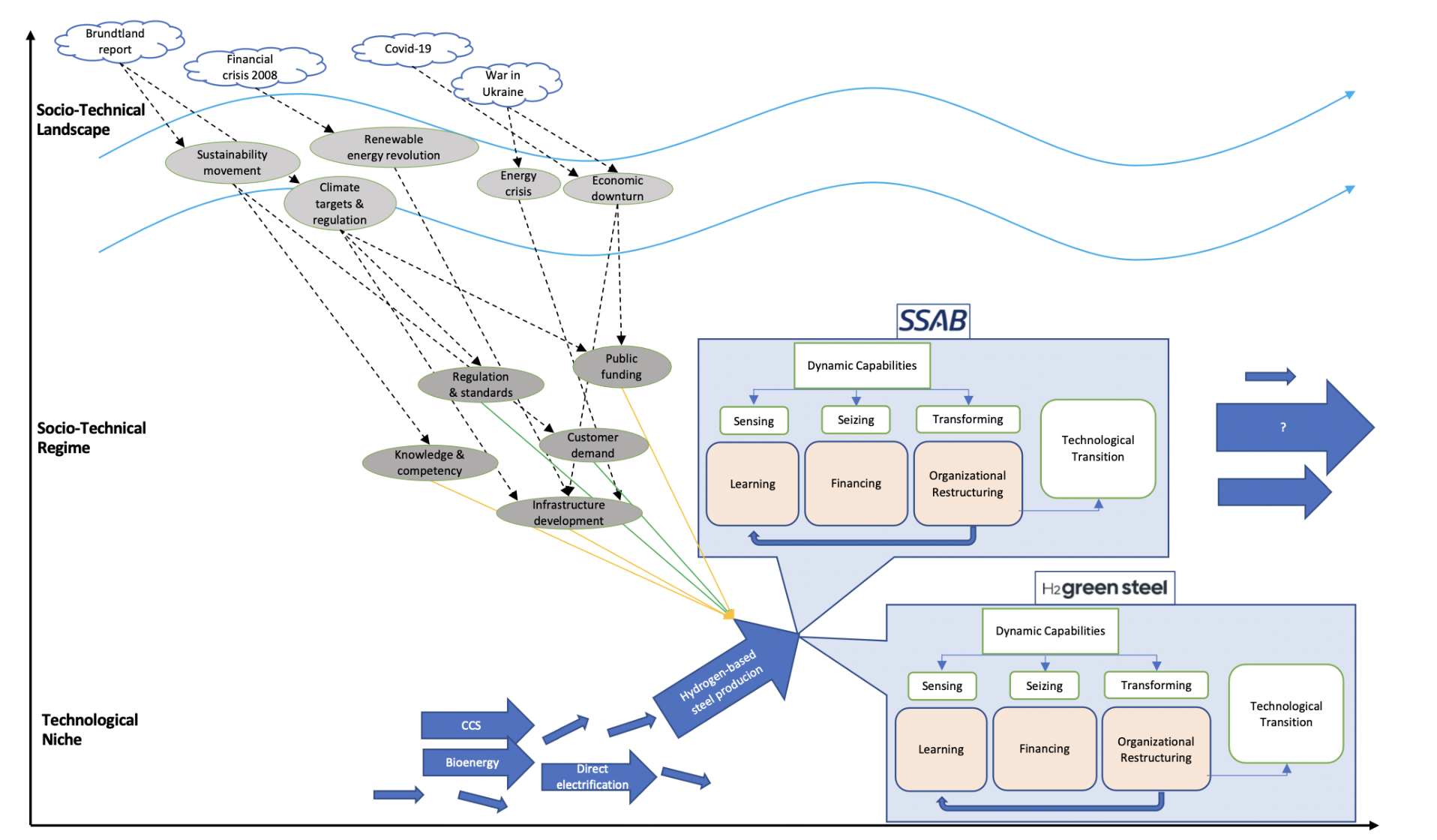By Isabella Bergström, Vendela Jonsson and Prof. Kristjan Jespersen
Climate change is one of the most defining issues of our time and human actions generate over 50 billion tonnes of greenhouse gas (GHG) emissions each year. In order to combat climate change and limit global warming, the Paris Agreement was formed in 2015, providing a framework for international cooperation. Sweden is one of the 196 nations that has signed the Paris Agreement, aiming to reach net-zero by 2045. The steel industry is one of the largest contributors to Sweden’s GHG emissions, accounting for ten percent of its total. Therefore, in order to decarbonize the nation, Sweden must decarbonize its steel industry. This has created pressure on Swedish steel companies to revise their sustainability strategies and explore new production technologies. The incumbent SSAB and the new entrant H2 Green Steel are the frontrunners in transforming the Swedish steel industry by developing the hydrogen-based steel (HBS) production technology.
To understand whether the steel industry can turn green, we decided to take a multi-level approach and analyze the micro-, meso- and macro-level factors affecting a potential transition. In particular, our study aimed to answer the following research question: “How will the potential sustainability transition of the Swedish steel industry develop and what are the respective roles of the incumbent SSAB and the new entrant H2GS in accelerating the transition?” In order to provide an answer to the research question, we took a qualitative methods approach through 15 semi-structured interviews with employees from SSAB and H2 Green Steel as well as external actors with knowledge of the steel industry, and conducted a comparative case study of the two firms.
We applied the Dynamic Capability (DC) framework, originally developed by David Teece (2008) and later improved by Strøm-Andersen (2018), to better understand what type of capabilities the firms are adopting in order to prepare for the transition. Additionally, we applied the Multi-Level Perspective (MLP) developed by Frank Geels (2002), to better understand the current state of the Swedish steel industry and the dimensions affecting the transition. By combining these two theories, we complemented the firm-level perspective with the industry-level perspective to understand the interactions between the firms and the industry. As Strøm-Andresen’s framework was used to study incumbent firms, we extended the applicability of the framework by using it to also analyze the dynamics between incumbents and new entrants in a sustainability transition. Conclusively, these theories in combination provided grounds to predict how a potential sustainability transition of the Swedish steel industry will develop, and what the roles of the incumbent and the new entrant are in accelerating it.
In the first part of the analysis, the DC perspective was applied to the respective companies, revealing that both firms adopted the DCs of learning, financing and organizational restructuring to prepare for the transition. The two firms were adopting these capabilities in different ways, where SSAB used its DCs to introduce the technology, and H2 Green Steel used its DCs to accelerate the development of it. However, some challenges were identified related to how the firms adopt their DCs, which are important for the firms to manage in order to optimally develop their DCs and successfully pursue a sustainability transition. In the second part of the analysis, the Swedish steel industry was analyzed using the MLP. The analysis revealed that the industry is affected by five landscape developments: 1) the Sustainability Movement, 2) Climate Targets & Regulations, 3) the Economic Downturn, 4) the Renewable Energy Revolution, and 5) the Energy Crisis. Moreover, it was found that the industry regime constitutes five main dimensions: 1) Regulation & Standards, 2) Customer Demand, 3) Public Funding, 4) Knowledge & Competency, and 5) Infrastructure Developments. Finally, the analysis revealed that there are currently four main technologies being developed at the niche level: 1) Carbon Capture & Storage, 2) Bioenergy, 3) HBS, and 4) Direct Electrification.
Conclusively, the findings revealed that several trigger events have led to landscape developments that have collectively created pressure on the steel industry regime to change, creating a window of opportunity for new niche-technologies to be developed. These sequences of events have led to the creation of several trajectories, some of which are aligned with the HBS development, and others that are misaligned. Conflicting pressures from a regime dimension, meaning that it is an enabler that is currently insufficient and therefore constitutes a barrier for the transition, results in a transition tension. In the Swedish steel industry, three dimensions generate transition tensions: 1. Knowledge & Competency, 2) Public Funding, and 3) Infrastructure Development. It was found that both SSAB and H2 Green Steel play a critical role in circumventing and resolving these tensions by efficiently adopting their DCs and in turn can help accelerate the transition of the Swedish steel industry.

About the authors
Isabella Bergström and Vendela Jonsson studied the master’s program in Finance and Strategic Management at Copenhagen Business School. They both have a great interest in sustainability, and after deep-diving into this topic through their elective courses and work, they felt the urge to explore it even further. They decided to investigate one of the most hard-to-abate industries – the steel industry, and how it potentially can be decarbonized. After completing their master’s degree they have both pursued a job in management consulting, and are hoping to continue to work on exploring solutions to tackle climate change by consulting clients on related matters.
Prof. Kristjan Jespersen is an Associate Professor in Sustainable Innovation and Entrepreneurship at the Copenhagen Business School (CBS). Kristjan is an Associate Professor at the Copenhagen Business School (CBS). As a primary area of focus, he studies the growing development and management of Ecosystem Services in developing countries. Within the field, Kristjan focuses his attention on the institutional legitimacy of such initiatives and the overall compensation tools used to ensure compliance. He has a background in International Relations and Economics.